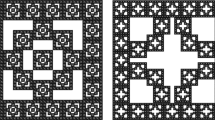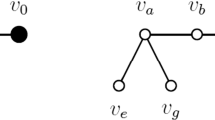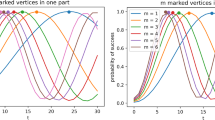Conclusion
I have exhibited several types of monotiles with matching rules that force the construction of a hexagonal parquet. The isohedral number of the resulting tiling can be made as large as desired by increasing the aspect ratio of the monotile. Aside from illustrating some elegant peculiarities of the hexagonal parquet tiling, the constructions demonstrate three points.
-
1.
Monotiles with arbitrarily large isohedral number do exist;
-
2.
The additional topological possibilities afforded in 3D allow construction of a simply connected monotile with a rule enforced by shape only, which is impossible for the hexagonal parquet in 2D;
-
3.
The precise statement of the tiling problem matters— whether color matching rules are allowed; whether multiply connected shapes are allowed; whether spacefilling is required as opposed to just maximum density. So what about the quest for thek = ∞ monotile? Schmitt.
Similar content being viewed by others
References
R. Penrose, “Pentaplexity,”Math. Intelligencer 2 (1979), 32–37.
M. Gardner, “Extraordinary nonperiodic tiling that enriches the theory of tiles,”Sci. Am. 236 (1977), 110–121.
R. Berger, “The undecidability of the Domino problem,”Mem. Amer. Math. Soc. 66 (1966), 1–72.
B. Grünbaum and G. C. Shephard,Tilings and Patterns, Freeman, New York (1987).
C. Goodman-Strauss, “A strongly aperiodic set of tiles in the hyperbolic plane,”Inventiones Mathematicae 159 (2005), 119–132.
J. S. Myers, “Polyomino tiling,” http://www.srcf.ucam.org/jsm28/ tiling/ (2005).
L. Danzer, “A family of 3D-spacefillers not permitting any periodic or quasiperiodic tiling,” inAperiodic ’94, edited by G. Chapuis World Scientific, Singapore (1995).
M. Baake and D. Frettloh, “SCD patterns have singular diffraction,”J. Math. Phys. 46 033510 (2005).
C. Radin, “Aperiodic tilings in higher dimensions,”Proc. American Mathematical Soc. 123(1995), 3543–3548.
P. Gummelt, “Penrose tilings as coverings of congruent decagons,”Geometriae Dedicata 62 (1996), 1–17.
P. J. Steinhardt and H.-C. Jeong, “A simpler approach to Penrose tiling with implications for quasicrystal formation,”Nature 382, 431–433 (1996).
T. C. Hales, “A proof of the Kepler conjecture,”Ann. of Math. 162 (2005), 1065–1185.
S. Torquato and F. H. Stillinger, “New conjectural lower bounds on the optimal density of sphere packings,” to appear,Experimental Mathematics 15, Issue 3 (2006).
Author information
Authors and Affiliations
Corresponding author
Additional information
An erratum to this article is available at http://dx.doi.org/10.1007/BF02986167.
Rights and permissions
About this article
Cite this article
Socolar, J.E.S. More ways to tile with only one shape polygon. The Mathematical Intelligencer 29, 33–38 (2007). https://doi.org/10.1007/BF02986203
Published:
Issue Date:
DOI: https://doi.org/10.1007/BF02986203




